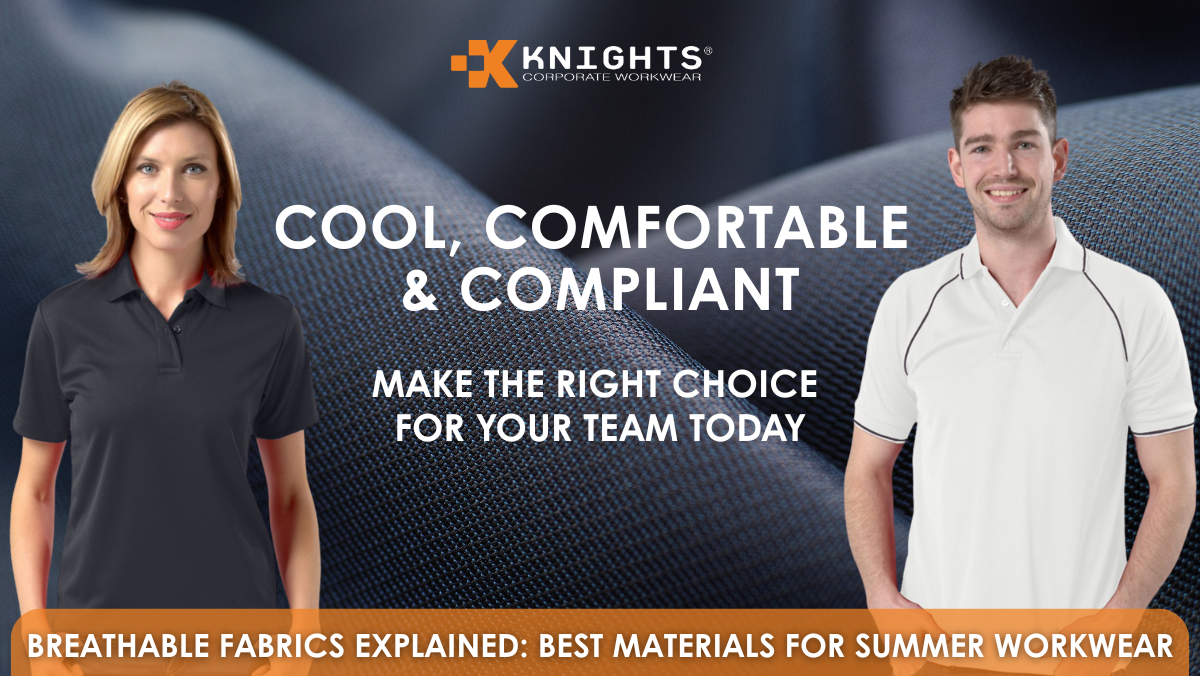Breathable Fabrics Explained: Best Materials for Summer Workwear
Jul 8 2025 1:39PM

When the temperature rises, so do the risks on site. Heat stress, fatigue, skin irritation, and reduced concentration can all take a toll on workers, especially when they’re wearing PPE or heavy-duty workwear. That’s why choosing the right breathable fabric is so important. It's not just a comfort issue, but also a safety and productivity decision.
At Knights Corporate Workwear, we’re trusted advisors to industries that can’t afford to cut corners when it comes to performance and protection. In this guide, we break down the best materials for summer workwear, including their pros, cons, and cost implications, so that you can make informed choices for what’s best for your team.
🔍 What Makes a Fabric “Breathable”?
A breathable fabric allows moisture and heat to escape from the body while preventing overheating. This usually means:
- Wicking away sweat
- Allowing airflow
- Drying quickly
- Reducing skin contact with moisture
Just because a workwear or PPE item is classed as “lightweight” or “summer-ready”, this doesn’t mean that it will keep you cool. In this blog, we’ll break down the top fabrics used in breathable workwear and PPE and show how they compare against each other.
🧵 1. Cotton: The Classic Natural Choice
Pros
- Soft and comfortable on skin
- Highly breathable due to natural fibres
- Absorbs moisture well
Cons
- Absorbs and holds sweat (gets heavy)
- Takes longer to dry
- Can shrink or wear faster with frequent washing
Best for: Indoor or shaded environments, light-duty workwear
Cost: Generally a low-budget, friendly option
Cotton is often a go-to fabric for summer due to its breathability. However, when used alone (100% cotton), it retains moisture rather than wicking it away, leading to discomfort on a hot, humid day. Cotton is often mixed with synthetic fibres to boost performance, making the final garment tougher, less likely to shrink, and better at holding its colour over time. It would also make the product quicker drying that 100% cotton.
🧪 2. Polyester: Lightweight and Durable
Pros
- Quick-drying
- Moisture-wicking properties
- Highly durable, fade-resistant
- Often treated for UV protection
Cons
- Less “natural feeling” than cotton
- Can retain odours if not treated
- May feel “clammy” without mesh or venting
Best for: Outdoor work, environments where durability matters
Cost: Moderate, varies based on quality and treatments
Modern polyester is often engineered for performance, especially in Hi-Vis and PPE garments. When blended or treated correctly, it offers exceptional temperature regulation and wear resistance.
🧵 3. Polycotton: The Best of Both Worlds?
Pros
- Combines comfort of cotton with strength of polyester
- Better shape retention and shrink resistance
- More breathable than pure polyester
- Often used in corporate and industrial uniforms
Cons
- Still absorbs some moisture
- May be less breathable than 100% cotton in some weaves
- Comfort can vary depending on blend ratios
Best for: General workwear, branded uniforms, moderate activity levels
Cost: Moderate - good value for versatility
With blends ranging from 65/35 to 50/50, polycotton is a popular and balanced choice for employers wanting comfort without sacrificing durability or budget.
🌬️ 4. Moisture-Wicking Technical Fabrics (e.g. Coolmax®, Dry-Fit, or Antimicrobial Meshes)
Pros
- Engineered for heat and sweat control
- Excellent airflow and cooling properties
- Odour-resistant options available
- Often used in base layers or high-performance outerwear
Cons
- Higher cost per garment
- May need layering with protective gear
- Requires careful laundering to preserve performance
Best for: High-intensity roles, extreme heat conditions, under-layer PPE systems
Cost: Higher - premium option, but worth the investment for frontline comfort
These fabrics are ideal for roles where staying dry is essential. We often recommend these for sectors like logistics, waste management, or construction, where workers are in motion for longer periods.
🦺 5. Ripstop and Lightweight Technical Weaves (Used in Work Trousers & Outerwear)
Pros
- Reinforced weave resists tearing without added weight
- Durable and breathable
- Suitable for rugged environments where safety is critical
Cons
- Not as soft as cotton
- May need lining for comfort
- Can feel stiff if not blended
Best for: Engineering, rail, utilities, or anywhere durability meets heat
Cost: Mid to high, depending on brand and treatment
When it’s not just the heat you’re up against for example, sharp edges, rough surfaces, or heavy-duty wear, ripstop fabrics are a great choice. The latest versions even come with built-in ventilation panels to help you stay cool.
👷 Final Thoughts: Comfort is Safety
When your team is cool, dry, and comfortable, they work more effectively and safely. Overheating can lead to slower reaction times, errors, and even medical emergencies.
Breathable fabrics aren't just a luxury in summer - they're a key part of PPE strategy.
We will help you select the right materials, styles, and products to keep your workforce protected, productive, and performing at their best, whatever the weather.
📩 Need help selecting the right summer workwear?
Get in touch for a free consultation or a demo of Knight-Link ®—our customised online ordering platform built for control, clarity, and compliance.
